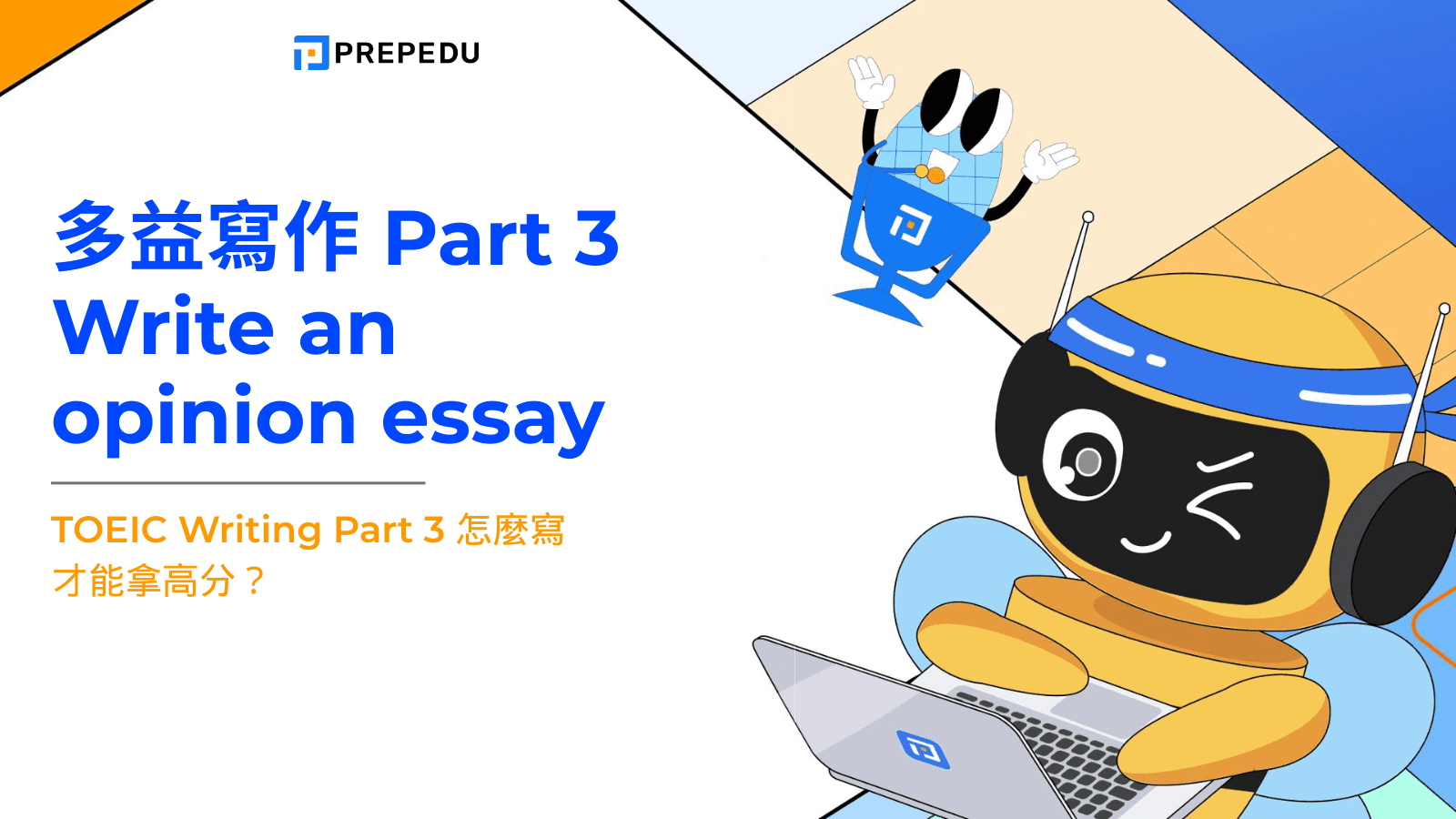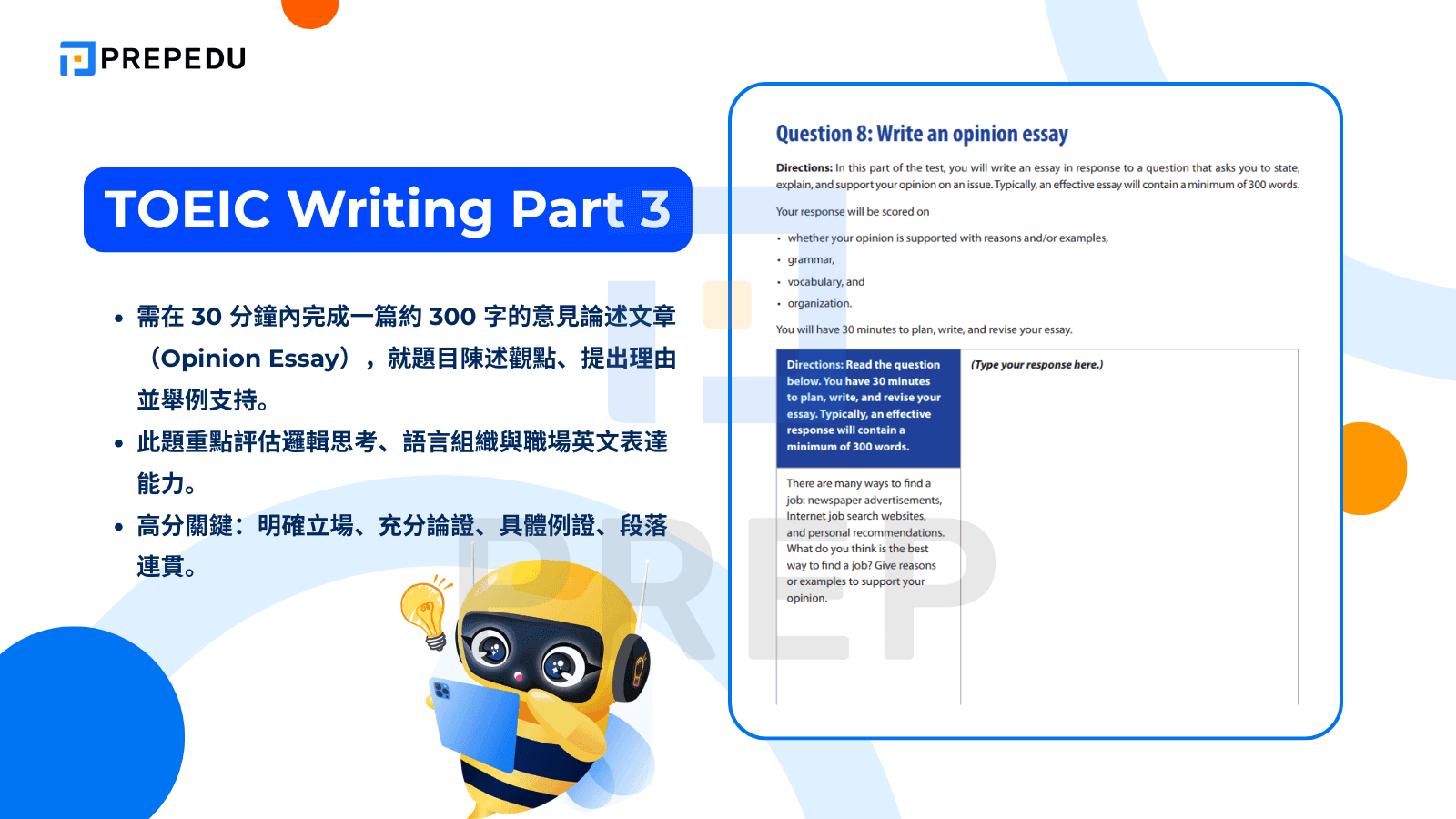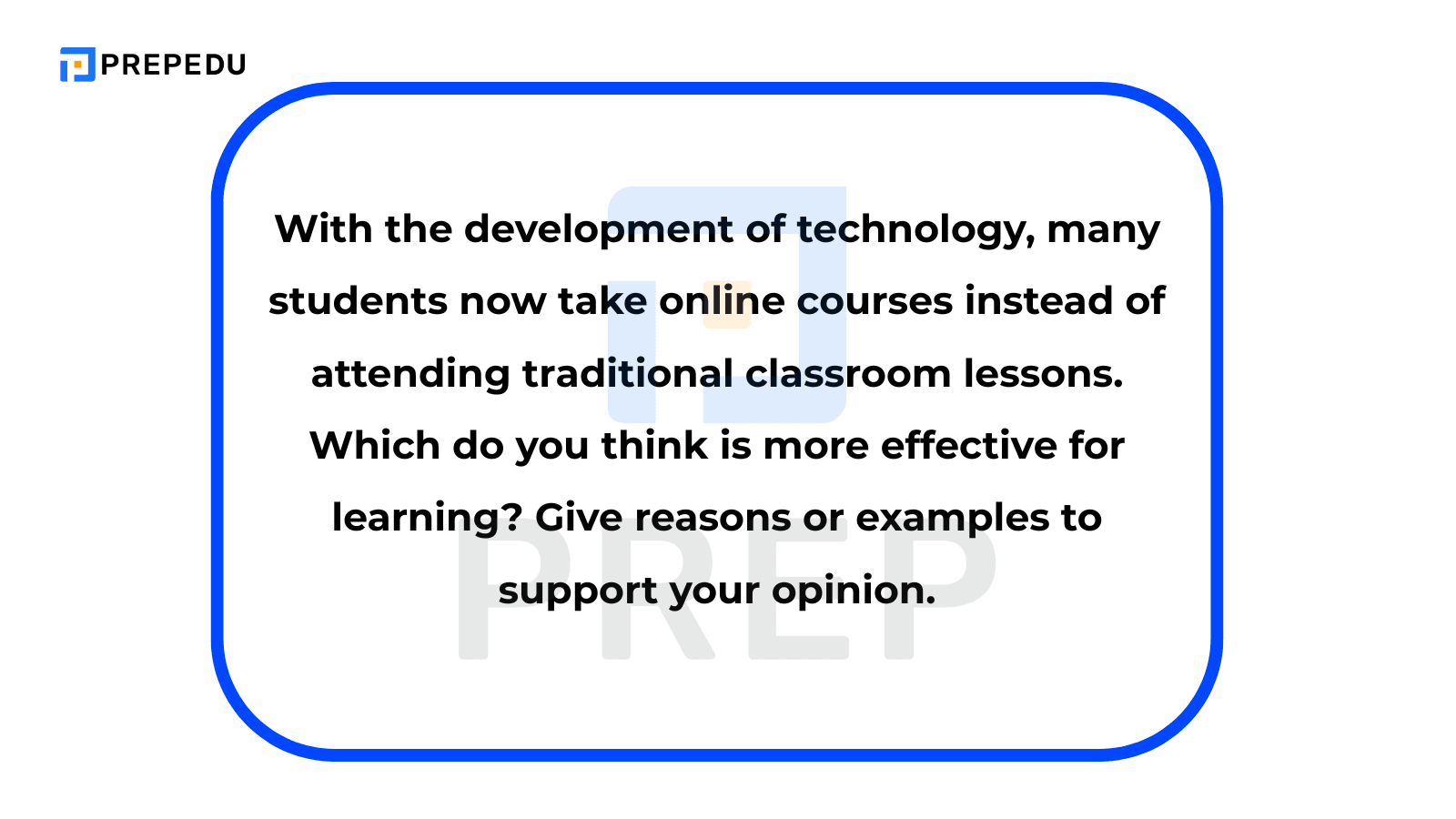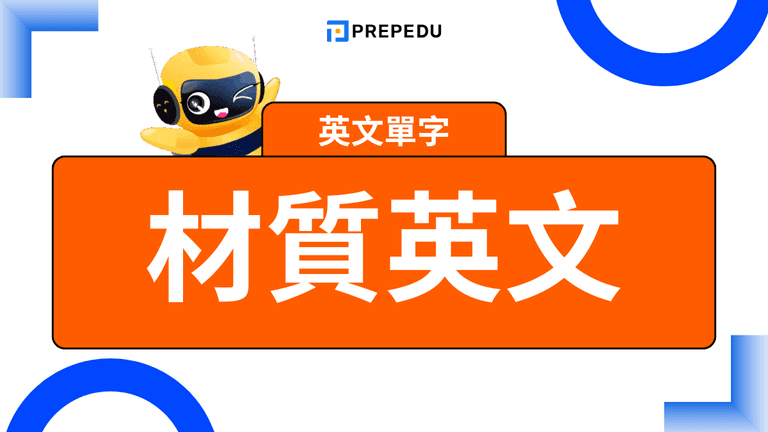TOEIC Writing Part 3 Write an opinion essay 滿分攻略:多益寫作 Part 3 意見闡述題型全解析
TOEIC Writing Part 3 怎麼寫才能拿高分? 這是許多台灣與香港考生面對多益寫作測驗時最關心的問題。根據 ETS 官方評分標準,TOEIC Writing Part 3 要求考生在 30 分鐘內完成至少 300 字的意見論述文章(Opinion essay),並從觀點支持度、文法正確性、詞彙運用與組織架構四大面向進行評分。許多考生因為不熟悉寫作流程、缺乏論點發展技巧,或是詞彙量不足,導致無法在時間內完成高品質文章,最終影響整體成績。
想像一下,當你面對「公司應該提供免費午餐給員工嗎?」這類題目時,能在腦海中立即浮現清晰的文章架構、具說服力的論點,以及豐富的實用句型——這正是高分考生與一般考生的關鍵差異。事實上,透過系統化的五步驟寫作流程、掌握常見主題的論點庫,以及熟記進階詞彙與句型,即使是寫作基礎較弱的考生也能在短時間內顯著提升表現。
PREPEDU 根據 ETS 官方指南與大量高分範文分析,為你整理出這份完整的 TOEIC Writing Part 3 滿分攻略。本文將深入解析題型要求、提供可複製的寫作流程、剖析高分範文結構,並分享超過 50 組實用詞彙與句型,幫助你在考場上從容應對各種題目,寫出邏輯清晰、論述完整的高分文章。

I. 深入了解 TOEIC Writing Part 3:題型要求與評分標準
1. 題型要求多益寫作 Part 3
TOEIC Writing Part 3(又稱 Question 8)是多益寫作測驗的最後一部分,也是最具挑戰性的題型。根據 ETS 官方指南,在這個部分考生會看到一個要求陳述、解釋並支持個人觀點的問題。你需要在 30 分鐘內撰寫一篇意見論述文章(Opinion essay)來回應題目,有效的文章通常包含至少 300 字。
這個題型測試的不僅是英語寫作能力,更考驗考生在國際職場與生活環境中運用英語進行書面溝通的實際能力。對於台灣與香港的考生而言,這個部分特別重要,因為它直接反映了在跨國企業工作時撰寫商業文件、提案報告或意見陳述的能力。
題型核心要求方面,TOEIC Writing Part 3 要求考生必須:
-
明確陳述個人觀點:你需要在文章中清楚表達自己對議題的立場(同意、反對或中立觀點)。
-
提供充分理由支持:單純表達意見不足以獲得高分,必須提出具邏輯性的理由來支撐你的論點。
-
舉出具體例證:使用實際例子、個人經驗或普遍觀察到的現象來強化論述的說服力。
-
維持文章連貫性:確保各段落之間邏輯清晰、轉折自然,讓評分者能輕鬆理解你的思路。

2. TOEIC Writing Part 3 常見主題歸納
|
主題分類 |
說明 |
題目示例 |
|
1. 職場與就業相關主題 |
這是 TOEIC Writing Part 3 中出現頻率最高的題型方向,反映了多益測驗以職場英語為核心的特性。 |
|
|
2. 科技與現代生活 |
科技對生活的影響是 TOEIC Writing Part 3 的熱門主題。 |
|
|
3. 教育與學習 |
教育相關主題也是 TOEIC Writing Part 3 的重要範疇。 |
|
|
4. 生活方式與個人選擇 |
日常生活相關的主題。 |
|
3. 評分標準 TOEIC Writing Part 3
官方評分標準詳解,根據 ETS 的評分準則,TOEIC Writing Part 3 主要從四個面向評估你的文章:
-
觀點支持度(Opinion Support) 你的意見是否獲得充分的理由與例子支持?評分者會檢視你的論證是否具說服力、例子是否切題且具體。在台灣與香港的多益考試情境中,能夠運用在地化的例子(如本地企業的實際案例)會讓論述更具真實性。
-
文法正確性(Grammar) 句型結構是否正確無誤?是否能靈活運用簡單句、複合句與複雜句來增加文章的豐富度?對於華語母語者而言,常見的文法錯誤包括:主詞動詞不一致(subject-verb agreement)、英文時態混亂(tense inconsistency)、介係詞誤用(preposition errors)、冠詞遺漏或誤用(article errors)。
-
詞彙運用(Vocabulary) 用字是否精準恰當?能否運用進階詞彙與專業術語?是否避免過度重複相同字詞?台灣與香港考生在準備時應特別注意避免直譯中文的表達方式,而是要學習道地的英語用法。
-
組織架構(Organization) 整體結構是否清晰有條理?段落之間的轉折是否流暢自然?文章是否有完整的引言、主體段落與結論?好的組織架構能讓評分者快速掌握你的論點,這在 TOEIC Writing Part 3 的評分中佔有重要地位。
評分等級說明(從 0 到 5 分):
|
分數 |
說明 |
|
0 分 |
未作答或答非所問 |
|
1 分 |
答案未切題,存在大量文法與詞彙錯誤 |
|
2 分 |
有回答問題但過於簡短,缺乏支持論點與證據,詞彙運用不當,文法錯誤明顯 |
|
3 分 |
回答問題並提供一些證據與例子,但組織架構不夠清晰,詞彙與文法運用仍有限制 |
|
4 分 |
提供適當的論點與證據,使用連接詞強化論述,詞彙豐富且包含進階用語,但仍有些許文法錯誤 |
|
5 分 |
完整回答問題並達到字數要求,論證深入且有說服力,使用適當的連接詞使文章邏輯清晰,詞彙與文法運用幾乎無明顯錯誤 |
掌握這些評分標準,能幫助你在準備 TOEIC Writing Part 3 時更有方向,針對評分重點進行強化練習。建議台灣與香港的考生在練習時,可以請英語教師或使用線上評分工具,根據這四個面向來檢視自己的文章表現。
請參考這裡的 TOEIC Writing 評分標準:多益口說寫作分數測驗完整解析:評分標準、分數計算與能力對照指南
II. 高分寫作五步驟:拆解 TOEIC Writing Part 3 Write an opinion essay 的寫作流程
一篇結構完整的 TOEIC Writing Part 3 高分文章並非一蹴可幾,而是需要依循系統化的步驟逐步建構。許多台灣與香港考生在面對 TOEIC Writing Part 3 考題時常因缺乏明確的寫作流程而感到慌亂,導致時間分配不當或論點發展不完整。
為了幫助你建立穩固的寫作基礎,接下來將詳細介紹從審題到最後檢查的五個關鍵步驟。這套流程經過驗證,能有效幫助考生在 30 分鐘內完成一篇高品質的 Opinion essay。透過反覆練習這套流程,你將能在考場上更從容地應對 TOEIC Writing Part 3 的各種題目,寫出邏輯清晰、論述完整的高分文章。
1. 步驟一:審題與腦力激盪 (3-5 分鐘)
開始撰寫 TOEIC Writing Part 3 之前,仔細審題是絕對不能省略的步驟。根據統計,約有 15% 的考生因為誤解題意而導致整篇文章偏離主題,這是非常可惜的失分。
|
關鍵字辨識技巧 |
拿到 TOEIC Writing Part 3 題目後,立即用筆圈出關鍵字詞。重點包括:
例如,題目「Do you agree or disagree that companies should provide free meals to employees?」中,關鍵字包括:agree/disagree、companies、provide、free meals、employees。 (你同意還是不同意公司應該提供免費餐點給員工?) |
|
立場確立策略 |
在 TOEIC Writing Part 3 中,選擇立場時要考慮哪一方較容易發揮。建議採用「可寫性優先原則」:
對台灣與香港考生而言,可以多思考本地的職場文化與生活經驗。例如,如果題目問「遠距工作是否有益」,你可以思考台北或香港的通勤時間、住房成本、工作型態等在地因素來選擇立場。 |
|
腦力激盪實用方法 |
|
2. 步驟二:建立文章架構 (2-3 分鐘)
完成腦力激盪後,立即擬定文章大綱至關重要。這個步驟能確保 TOEIC Writing Part 3 文章結構清晰、論點不偏離主題,也能幫助你在寫作過程中節省思考時間。許多台灣與香港的高分考生都強調,花 2-3 分鐘規劃架構,能讓後續寫作更順暢,避免寫到一半卡住或離題。
以下提供一個適用於大多數 TOEIC Writing Part 3 題目的標準四段式架構:
|
段落結構 |
內容要點 |
字數分配 |
|
引言 (Introduction) |
|
50-60 字 |
|
正文段落一 (Body Paragraph 1) |
|
100-120 字 |
|
正文段落二 (Body Paragraph 2) |
|
100-120 字 |
|
結論 (Conclusion) |
|
50-60 字 |
架構規劃實例:假設 TOEIC Writing Part 3 題目是:「Do you agree that employees should be allowed to work from home?」(你同意應該允許員工在家工作嗎?)
你的快速大綱可以是:立場:Agree(同意)
|
引言 |
|
|
主體一:提升工作效率 |
|
|
主體二:改善生活品質 |
|
|
結論 |
|
這個架構的優點在於邏輯清晰、容易掌握,而且能確保你的 TOEIC Writing Part 3 文章至少達到 300 字的基本要求。在草稿紙上快速列出這個架構,能讓你在撰寫時更有條理,不會遺漏重要論點。
3. 步驟三:撰寫具吸引力的引言 (約 5 分鐘)
引言是評分者對你 TOEIC Writing Part 3 文章的第一印象,因此特別重要。根據經驗,一個好的引言應該在 50-60 字左右,包含兩個核心元素。
|
背景陳述 (Hook) |
背景陳述 (Hook) 是引言的開場白,目的是引起評分者的興趣並自然帶入主題。對於 TOEIC Writing Part 3,你可以採用以下開頭方式:
|
|
立場闡明 (Thesis Statement) |
立場闡明 (Thesis Statement) 是引言中最關鍵的部分。你必須用一句話清楚表達自己在 TOEIC Writing Part 3 中的核心觀點,讓評分者立即了解你的立場。
|
完整引言範例(TOEIC Writing Part 3):
題目:Do you agree that companies should provide free lunch to their employees? (你同意公司應該為員工提供免費午餐嗎?)
|
In today's competitive business environment, many organizations are seeking innovative ways to attract and retain talented employees. One such approach that has gained popularity in major cities like Taipei and Hong Kong is offering complimentary meals during working hours. From my perspective, companies should indeed provide free lunch to their staff, as this practice brings substantial benefits to both employers and employees. |
(在當今競爭激烈的商業環境中,許多組織正在尋求創新方式來吸引和留住優秀員工。在台北和香港等主要城市中,一種越來越受歡迎的做法是在工作時間提供免費餐點。從我的角度來看,公司確實應該為員工提供免費午餐,因為這種做法為雇主和員工都帶來實質的好處。)
記住,在 TOEIC Writing Part 3 中,立場必須明確且具體,避免模稜兩可的表達方式。台灣與香港考生常犯的錯誤是立場不夠清楚,使用「maybe」「perhaps」等詞語削弱了論點的力度。

4. 步驟四:發展具說服力的正文段落 (約 15 分鐘)
正文段落是 TOEIC Writing Part 3 的核心部分,也是展現你論述能力的關鍵所在。這個部分應佔用最多的時間(約 15 分鐘),因為它決定了你的文章是否具有說服力。要寫出具說服力的正文,建議採用「P.E.E.L. 結構法」,這是一個經過驗證有效的段落發展方式。
|
Point (論點) - 主題句 |
每段開頭的主題句必須清楚點出該段的核心論點,讓讀者立即知道這一段要討論什麼。好的主題句應該:
範例主題句:
|
|
Evidence (證據) - 具體例子 |
這是支持主題句的具體內容。在 TOEIC Writing Part 3 中,你需要提供實際例子、統計數據、個人經驗或普遍觀察到的現象來佐證論點。對台灣與香港考生而言,使用在地化的例子會更具說服力。 有效的證據類型:
|
|
Explanation (解釋) - 連結證據與論點 |
這是連結證據與論點的橋樑。你需要解釋為什麼你提供的證據能支持主題句,以及這對整體論點有什麼意義。這個部分常被 TOEIC Writing Part 3 考生忽略,但它對深化論述非常重要。 解釋範例:This extra time allows employees to spend more quality hours with their families, pursue personal hobbies, or simply get adequate rest, leading to improved mental health and higher job satisfaction. When people are not exhausted from long commutes, they can dedicate more energy to their work responsibilities and maintain better focus throughout the day. (這額外的時間讓員工能夠花更多優質時光與家人相處、追求個人興趣,或只是獲得充足的休息,從而改善心理健康並提高工作滿意度。當人們不再因長途通勤而疲憊時,他們可以將更多精力投入工作職責,並在整天保持更好的專注力。) |
|
Link (連結) - 段落小結 |
段落結尾的小結,目的是將本段論點與文章主旨連結起來,為下一段做好過渡。這能讓你的 TOEIC Writing Part 3 文章更有整體性。 連結範例:
|
完整正文段落範例(TOEIC Writing Part 3):
主體段落一:
|
The primary advantage of free lunch programs is the significant improvement in employee morale and job satisfaction (Point). When companies demonstrate genuine care for their workforce by providing quality meals, employees feel valued and appreciated (Evidence). For instance, at a technology company in Taipei where I previously worked, the introduction of a free lunch policy led to a remarkable increase in employee engagement scores, rising from 65% to 82% within six months (Evidence). This sense of being cared for creates a positive work culture where employees are more motivated to contribute their best efforts (Explanation). Additionally, staff members no longer need to spend time traveling to restaurants or worrying about meal expenses during busy workdays, allowing them to focus more effectively on their tasks (Explanation). This combination of emotional satisfaction and practical convenience ultimately enhances overall productivity and reduces staff turnover (Link). |
(免費午餐計畫的主要優勢是顯著改善員工士氣和工作滿意度(論點)。當公司透過提供優質餐點來展現對員工的真誠關懷時,員工會感到被重視和感激(證據)。例如,在我之前工作的台北一家科技公司,免費午餐政策的引入導致員工投入度評分顯著提升,在六個月內從 65% 上升到 82%(證據)。這種被照顧的感覺創造了一個正面的工作文化,員工更有動力貢獻他們最好的努力(解釋)。此外,員工不再需要花時間前往餐廳或在繁忙的工作日擔心用餐費用,使他們能夠更有效地專注於任務(解釋)。這種情感滿足和實際便利的結合最終提升了整體生產力並減少了員工流失(連結)。)
主體段落二:
|
Another compelling reason for providing free meals is the positive impact on employee health and wellness (Point). Office workers often skip meals or rely on unhealthy fast food due to time constraints during busy workdays (Evidence). By offering nutritious, well-balanced meals, companies can help their staff maintain better eating habits and prevent health issues related to poor nutrition (Explanation). A notable example is Google's cafeteria system, which has been implemented in their Hong Kong office, offering diverse healthy options including vegetarian and low-sodium dishes (Evidence). Studies show that employees who have access to healthy meals at work experience fewer sick days and demonstrate better concentration levels, which directly benefits both individual performance and company operations (Explanation). When employees are healthier and more energized, they perform better in their roles and require less medical leave, ultimately contributing to the organization's success (Link). |
(提供免費餐點的另一個令人信服的理由是對員工健康和福祉的正面影響(論點)。辦公室工作者經常因忙碌工作日的時間限制而跳過用餐或依賴不健康的速食(證據)。透過提供營養豐富、均衡的餐點,公司可以幫助員工維持更好的飲食習慣,並預防與營養不良相關的健康問題(解釋)。一個著名的例子是谷歌的餐廳系統,已在他們的香港辦公室實施,提供包括素食和低鈉菜餚在內的多樣化健康選擇(證據)。研究顯示,在工作場所能獲得健康餐點的員工病假天數較少,並展現出更好的專注力水平,這直接有利於個人表現和公司營運(解釋)。當員工更健康、更有活力時,他們在角色中表現得更好,需要的病假也更少,最終為組織的成功做出貢獻(連結)。)
撰寫 TOEIC Writing Part 3 正文段落的關鍵提醒:
-
兩個正文段落的論點應各自獨立且不重複
-
每段至少包含一個具體例子
-
使用轉折詞和連接詞使段落流暢(Furthermore, Moreover, Additionally, In addition)
-
避免過度使用第一人稱(I think, I believe)
-
確保每段落約 100-120 字
5. 步驟五:完成強而有力的結論與檢查 (約 5 分鐘)
結論是 TOEIC Writing Part 3 文章的收尾,也是給評分者留下最後印象的機會。雖然結論通常只有 50-60 字,但它對整體評分仍有重要影響。最後的 2-3 分鐘檢查更是不可忽略,能有效避免因小錯誤而失分。
撰寫有效結論的三個要素:
|
總結摘要 (Summary) |
用不同的詞語簡要重述正文中的主要論點。切記不要直接複製貼上前面的句子,而是換個方式表達相同的意思。 改寫技巧範例:
|
|
重申觀點 (Restate Thesis) |
再次強調你的核心立場,與引言中的 thesis statement 相呼應。這能讓你的 TOEIC Writing Part 3 文章首尾呼應,結構完整。 常用的結論開頭用語:
重申觀點範例:In conclusion, considering the substantial improvements in employee satisfaction and health outcomes, I firmly believe that providing free lunch represents a worthwhile investment for companies operating in competitive markets like Taiwan and Hong Kong.(總而言之,考慮到員工滿意度和健康成果的顯著改善,我堅信提供免費午餐對於在台灣和香港等競爭激烈的市場營運的公司而言,是一項值得的投資。) |
|
提出展望或建議 (Future Outlook - Optional) |
在 TOEIC Writing Part 3 中,你可以對未來提出建議或預測,讓文章結尾更具深度。不過這個部分是選擇性的,如果時間緊迫可以省略。 展望範例:
|
完整結論範例(TOEIC Writing Part 3):
|
In conclusion, based on the significant benefits of enhanced employee morale and improved health outcomes, I strongly support the implementation of free lunch programs in modern organizations. Companies that invest in their employees' wellbeing through such initiatives not only create a more positive work environment but also reap the rewards of increased productivity and reduced turnover rates. As the business landscape becomes increasingly competitive, particularly in dynamic markets like Hong Kong and Taiwan, providing complimentary meals may well become a standard practice that separates successful companies from their competitors. |
(總而言之,基於提升員工士氣和改善健康成果的顯著好處,我強烈支持在現代組織中實施免費午餐計畫。透過這類措施投資於員工福祉的公司不僅創造了更正面的工作環境,還獲得了提升生產力和降低流失率的回報。隨著商業環境變得越來越競爭,特別是在香港和台灣等充滿活力的市場,提供免費餐點很可能成為區分成功公司與競爭對手的標準做法。)
III. 高分範文解析(TOEIC Writing Part 3)
1. 範例一:找工作的最佳方式(職場與就業)
題目:
|
There are many ways to find a job: newspaper advertisements, Internet job search websites, and personal recommendations. What do you think is the best way to find a job? Give reasons or examples to support your opinion. |
(有許多找工作的方式:報紙廣告、網路求職網站和個人推薦。你認為找工作的最佳方式是什麼?提供理由或例子來支持你的觀點。)

高分範文(約 340 字):
|
In today's digital age, job seekers have access to various channels for finding employment opportunities, including traditional newspaper advertisements, modern Internet job search platforms, and personal recommendations from their networks. From my perspective, utilizing Internet job search websites represents the most effective approach for several compelling reasons. The primary advantage of online job platforms is their unparalleled accessibility and convenience. Unlike newspaper advertisements that are published only once daily and have limited space, Internet job search websites such as LinkedIn, Indeed, and 104 Job Bank in Taiwan operate 24/7 and feature thousands of job postings updated in real-time. For instance, when my colleague Jessica was searching for a marketing position in Taipei last year, she could browse through over 200 relevant openings within an hour on various platforms, applying to multiple positions simultaneously. This efficiency would be impossible to achieve through traditional newspaper classified ads, which require manually checking each day's publication and physically mailing application documents. Another significant benefit is the comprehensive information and advanced search features that online platforms provide. These websites typically include detailed job descriptions, company profiles, salary ranges, and even employee reviews, enabling candidates to make well-informed decisions before applying. Moreover, sophisticated filtering systems allow users to narrow down opportunities based on specific criteria such as location, industry, experience level, and expected compensation. In contrast, newspaper advertisements usually contain minimal information due to space constraints, and personal recommendations may lack objectivity or overlook opportunities outside one's immediate network. In conclusion, while traditional methods like newspaper ads and personal connections still have their place in job hunting, Internet job search websites offer superior efficiency, information accessibility, and search capabilities. For job seekers in competitive markets like Taiwan and Hong Kong, leveraging these digital platforms provides the best chance of finding suitable employment opportunities that align with their career goals. |
中文翻譯:
「在當今的數位時代,求職者可以透過各種管道尋找就業機會,包括傳統的報紙廣告、現代網路求職平台和來自人脈網絡的個人推薦。從我的角度來看,使用網路求職網站代表最有效的方法,原因有幾個令人信服的理由。
線上求職平台的主要優勢是其無與倫比的可及性和便利性。與每天只發布一次且空間有限的報紙廣告不同,像是 LinkedIn、Indeed 和台灣的 104 人力銀行等網路求職網站全天候運作,並提供數千個即時更新的職位。例如,去年當我的同事 Jessica 在台北尋找行銷職位時,她可以在一小時內瀏覽各種平台上超過 200 個相關職缺,同時申請多個職位。這種效率透過傳統的報紙分類廣告是不可能實現的,因為需要每天手動檢查出版物並實體郵寄申請文件。
另一個顯著的好處是線上平台提供的全面資訊和進階搜尋功能。這些網站通常包含詳細的職位描述、公司簡介、薪資範圍,甚至員工評論,使應徵者能在申請前做出明智的決定。此外,精密的篩選系統允許使用者根據具體標準縮小機會範圍,如地點、產業、經驗水平和期望薪酬。相比之下,報紙廣告由於空間限制通常只包含最少的資訊,而個人推薦可能缺乏客觀性或忽略了直接人脈網絡之外的機會。
總而言之,雖然報紙廣告和個人關係等傳統方法在求職中仍有其地位,但網路求職網站提供了優越的效率、資訊可及性和搜尋能力。對於台灣和香港等競爭激烈市場的求職者而言,利用這些數位平台提供了找到符合職業目標的合適就業機會的最佳機會。」
2. 範例二:智慧型手機對日常生活的影響(科技與現代生活)
題目:
|
Smartphones have become an essential part of modern life. Some people believe smartphones have improved our lives, while others think they have created new problems. What is your opinion? Give reasons or examples to support your answer. |
(智慧型手機已成為現代生活中不可或缺的一部分。有些人認為智慧型手機改善了我們的生活,而另一些人認為它們造成了新問題。你的看法是什麼?提供理由或例子來支持你的答案。)

高分範文(約 345 字):
|
Smartphones have revolutionized virtually every aspect of contemporary society, from communication and entertainment to commerce and education. While critics raise valid concerns about potential negative effects, I believe that smartphones have fundamentally improved our lives by enhancing connectivity, productivity, and access to information. The most significant advantage of smartphones is their ability to keep people connected regardless of geographical distance. Through applications like LINE, WhatsApp, and WeChat, individuals can maintain relationships with family members, friends, and colleagues across continents through instant messaging, video calls, and social media updates. My grandmother in Kaohsiung, who is 78 years old, now regularly video calls with my uncle's family in Vancouver every weekend using her smartphone. This technology has strengthened their family bonds in ways that were impossible just a decade ago when international communication required expensive phone calls or written letters that took weeks to arrive. Furthermore, smartphones serve as powerful productivity tools that consolidate numerous functions into a single portable device. Modern smartphones effectively replace cameras, alarm clocks, calculators, maps, notebooks, and entertainment systems, enabling users to accomplish diverse tasks efficiently. For instance, during my business trip to Tokyo last month, I used my smartphone to navigate unfamiliar subway routes, translate Japanese menus in real-time, manage my work emails, attend virtual meetings, and capture professional-quality photographs—all without carrying multiple separate devices. This convenience has transformed how professionals conduct business and manage their daily responsibilities. In conclusion, despite legitimate concerns about smartphone addiction and reduced face-to-face interaction, the overwhelming benefits these devices provide—including enhanced global connectivity, unprecedented convenience, and improved productivity—demonstrate that smartphones have genuinely improved modern life. The key lies not in rejecting this technology but in using it mindfully and establishing healthy usage habits that maximize benefits while minimizing potential drawbacks. |
中文翻譯:
「智慧型手機幾乎徹底改變了當代社會的每個方面,從溝通和娛樂到商業和教育。雖然批評者提出了關於潛在負面影響的合理擔憂,但我相信智慧型手機透過增強連接性、生產力和資訊獲取,從根本上改善了我們的生活。
智慧型手機最顯著的優勢是無論地理距離如何,都能讓人們保持聯繫。透過 LINE、WhatsApp 和 WeChat 等應用程式,個人可以透過即時訊息、視訊通話和社群媒體更新,與跨越大陸的家人、朋友和同事保持關係。我在高雄的祖母今年 78 歲,現在每個週末都會用她的智慧型手機與我叔叔在溫哥華的家人定期視訊通話。這項技術以十年前不可能的方式加強了他們的家庭聯繫,當時國際通訊需要昂貴的電話或需要數週才能送達的書信。
此外,智慧型手機作為強大的生產力工具,將眾多功能整合到一個便攜式裝置中。現代智慧型手機有效地取代了相機、鬧鐘、計算機、地圖、筆記本和娛樂系統,使用戶能夠高效地完成各種任務。例如,上個月我在東京出差期間,我使用智慧型手機導航陌生的地鐵路線、即時翻譯日文菜單、管理工作電子郵件、參加虛擬會議並拍攝專業品質的照片——所有這些都無需攜帶多個單獨的裝置。這種便利性改變了專業人士開展業務和管理日常責任的方式。
總而言之,儘管對智慧型手機成癮和面對面互動減少存在合理的擔憂,但這些裝置提供的壓倒性好處——包括增強的全球連接性、前所未有的便利性和改善的生產力——證明智慧型手機確實改善了現代生活。關鍵不在於拒絕這項技術,而在於有意識地使用它,並建立健康的使用習慣,以最大限度地提高好處,同時最小化潛在的缺點。」
3. 範例三:線上學習與傳統課堂教學(教育與學習)
題目:
|
With the development of technology, many students now take online courses instead of attending traditional classroom lessons. Which do you think is more effective for learning? Give reasons or examples to support your opinion. |
(隨著科技的發展,許多學生現在選擇線上課程而不是參加傳統課堂教學。你認為哪一種學習方式更有效?提供理由或例子來支持你的觀點。)

高分範文(約 335 字):
|
The rise of digital learning platforms has sparked considerable debate about the relative effectiveness of online education versus traditional classroom instruction. While both approaches have distinct advantages, I believe that online learning offers greater flexibility and accessibility, making it more effective for most adult learners in today's fast-paced world. Online courses provide unmatched flexibility that accommodates diverse schedules and learning paces. Unlike traditional classrooms with fixed meeting times, online platforms allow students to access lectures, complete assignments, and participate in discussions according to their personal schedules. This flexibility proves especially valuable for working professionals who need to balance career responsibilities with educational pursuits. For example, my colleague Jennifer, a marketing manager in Hong Kong, recently completed her MBA through an online program while maintaining her full-time position. She typically studied between 9 PM and midnight after her children went to bed, a schedule that would have been impossible with traditional evening classes that require physical attendance at specific times. Moreover, online learning democratizes education by removing geographical barriers and reducing costs. Students in remote areas or smaller cities can access high-quality courses from prestigious institutions worldwide without relocating or commuting long distances. Platforms like Coursera, edX, and Taiwan's own MOOC programs offer courses from top universities at a fraction of traditional tuition costs, often without requiring students to take entrance examinations. My cousin in Hualien, for instance, studied data science through courses from National Taiwan University and Stanford University without ever leaving his hometown, something that would have required moving to Taipei and incurring substantial living expenses in a traditional education model. In conclusion, while traditional classrooms excel at providing immediate feedback and fostering peer interaction, online learning's superior flexibility, accessibility, and cost-effectiveness make it the more practical and effective option for continuous learning in the modern era. |
中文翻譯:
「數位學習平台的興起引發了關於線上教育與傳統課堂教學相對效果的大量辯論。雖然兩種方法都有明顯的優勢,但我相信線上學習提供了更大的靈活性和可及性,使其對當今快節奏世界中的大多數成人學習者更加有效。
線上課程提供無與倫比的靈活性,可以適應不同的時間表和學習節奏。與具有固定上課時間的傳統課堂不同,線上平台允許學生根據個人時間表觀看講座、完成作業和參與討論。這種靈活性對需要平衡職業責任和教育追求的在職專業人士特別有價值。例如,我的同事 Jennifer 是香港的行銷經理,最近透過線上課程完成了 MBA 學位,同時保持全職工作。她通常在孩子上床睡覺後的晚上 9 點到午夜之間學習,這種時間表在需要特定時間實體出席的傳統夜間課程中是不可能實現的。
此外,線上學習透過消除地理障礙和降低成本來使教育民主化。偏遠地區或小城市的學生可以獲得來自世界各地著名機構的高品質課程,而無需搬遷或長途通勤。像 Coursera、edX 和台灣自己的 MOOC 課程等平台以傳統學費的一小部分提供頂尖大學的課程,通常不需要學生參加入學考試。例如,我在花蓮的表弟透過國立台灣大學和史丹佛大學的課程學習資料科學,從未離開過他的家鄉,而在傳統教育模式中,這需要搬到台北並產生大量的生活費用。
總而言之,雖然傳統課堂在提供即時回饋和促進同儕互動方面表現出色,但線上學習優越的靈活性、可及性和成本效益使其成為現代持續學習更實用和有效的選擇。」
4. 範例四:健康飲食的重要性(生活方式與個人選擇)
題目:
|
Some people prefer to eat home-cooked meals, while others prefer to eat at restaurants or buy ready-made food. Which do you think is better? Give reasons or examples to support your opinion. |
(有些人喜歡吃家常菜,而另一些人喜歡在餐廳用餐或購買即食食品。你認為哪一種比較好?提供理由或例子來支持你的觀點。)

高分範文(約 340 字):
|
In modern urban societies, people face daily decisions about how to obtain their meals, choosing between preparing food at home, dining at restaurants, or purchasing convenient ready-made options. Although eating out offers undeniable convenience, I strongly believe that home-cooked meals represent the superior choice for both health and financial reasons. The primary advantage of cooking at home is the ability to control ingredients and maintain nutritional quality. Restaurant meals and processed foods typically contain excessive amounts of sodium, sugar, and unhealthy fats to enhance flavor and extend shelf life, contributing to various health problems including obesity, hypertension, and cardiovascular disease. When preparing meals at home, individuals can select fresh ingredients, adjust seasoning levels, and ensure balanced nutrition according to their specific dietary needs. My father, who was diagnosed with high blood pressure three years ago, began cooking most meals at home instead of eating out frequently. By controlling salt intake and incorporating more vegetables and whole grains, he successfully reduced his blood pressure medication dosage by half within six months, demonstrating the tangible health benefits of home cooking. Additionally, preparing food at home offers substantial financial savings compared to regular restaurant dining or purchasing prepared meals. While the initial time investment may seem significant, home cooking typically costs one-third to one-half the price of equivalent restaurant meals. For instance, a family of four in Taipei might spend NT$1,500-2,000 for a modest restaurant dinner, whereas the same meal prepared at home would cost approximately NT$500-600 for ingredients. Over a month, this difference accumulates to thousands of dollars in savings that can be allocated toward other important family needs or long-term financial goals. In conclusion, despite the convenience that restaurants and ready-made foods provide for busy lifestyles, home-cooked meals offer superior nutritional control, significant cost savings, and better long-term health outcomes, making them the optimal choice for individuals and families prioritizing well-being and financial responsibility. |
中文翻譯:
「在現代都市社會中,人們每天都面臨如何獲得餐食的決定,在家準備食物、在餐廳用餐或購買方便的即食食品之間做出選擇。儘管外食提供了不可否認的便利性,但我堅信家常菜出於健康和財務原因是更優越的選擇。
在家烹飪的主要優勢是能夠控制食材並維持營養品質。餐廳餐點和加工食品通常含有過量的鈉、糖和不健康的脂肪,以增強風味和延長保質期,導致各種健康問題,包括肥胖、高血壓和心血管疾病。在家準備餐點時,個人可以選擇新鮮食材、調整調味水平,並根據其特定的飲食需求確保均衡營養。我的父親三年前被診斷出高血壓,他開始在家烹飪大部分餐點,而不是經常外食。透過控制鹽的攝入量並納入更多蔬菜和全穀物,他在六個月內成功將血壓藥物劑量減少了一半,證明了家庭烹飪的實際健康益處。
此外,與經常在餐廳用餐或購買預製餐點相比,在家準備食物可以節省大量費用。雖然最初的時間投資可能看起來很重要,但家庭烹飪的成本通常是同等餐廳餐點價格的三分之一到二分之一。例如,台北的一個四口之家可能會在餐廳用餐花費 1,500-2,000 新台幣,而在家準備相同的餐點,食材成本約為 500-600 新台幣。一個月下來,這種差異累積成數千元的節省,可以分配給其他重要的家庭需求或長期財務目標。
總而言之,儘管餐廳和即食食品為繁忙的生活方式提供了便利,但家常菜提供了優越的營養控制、顯著的成本節省和更好的長期健康結果,使其成為優先考慮健康和財務責任的個人和家庭的最佳選擇。」
IV. 加分必備:TOEIC Writing Part 3 進階詞彙與實用句型庫
掌握豐富的詞彙與多樣的句型是在 TOEIC Writing Part 3 中脫穎而出的關鍵。以下按照功能分類整理實用詞彙與表達方式,並以表格形式呈現,方便台灣與香港考生記憶與運用。每個TOEIC詞彙都配有 IPA 音標、中文意思和獨特的例句。
1. 表達觀點與立場的詞彙
|
英文詞彙 |
中文意思 |
例句 |
|
perspective /pəˈspektɪv/ |
觀點;看法 |
From Chen's perspective as a startup founder in Taipei, flexible working hours help attract talented engineers who value work-life balance. (從陳先生作為台北新創公司創辦人的觀點來看,彈性工時有助於吸引重視工作生活平衡的優秀工程師。) |
|
conviction /kənˈvɪkʃn/ |
堅定的信念;確信 |
It is my strong conviction that companies investing in employee wellness programs will see reduced healthcare costs and improved productivity in the long run. (我堅信投資於員工健康計畫的公司長期而言將看到醫療成本降低和生產力提升。) |
|
standpoint /ˈstændpɔɪnt/ |
立場;觀點 |
From an environmental standpoint, Maria believes that remote work significantly reduces carbon emissions from daily commuting in congested cities like Hong Kong. (從環境保護的立場來看,Maria 認為遠距工作顯著減少了像香港這樣擁擠城市的日常通勤碳排放。) |
|
firmly /ˈfɜːmli/ |
堅定地;牢固地 |
The HR director firmly believes that providing free language training courses will enhance employees' global competitiveness and benefit the company's international expansion. (人力資源總監堅定地相信提供免費語言培訓課程將提升員工的全球競爭力,並有益於公司的國際擴張。) |
|
contend /kənˈtend/ |
主張;聲稱 |
David contends that traditional face-to-face meetings in the Taipei office foster stronger team collaboration than virtual conferences through video calls. (David 主張台北辦公室的傳統面對面會議比透過視訊通話的虛擬會議更能培養更強的團隊合作。) |
2. 提出理由與論點的詞彙
|
英文詞彙 |
中文意思 |
例句 |
|
compelling /kəmˈpelɪŋ/ |
令人信服的;引人注目的 |
Sarah presented compelling evidence from her research in Hong Kong showing that employees with flexible schedules report 40% higher job satisfaction rates. (Sarah 提出了她在香港研究中令人信服的證據,顯示擁有彈性時間表的員工報告的工作滿意度高出 40%。) |
|
substantial /səbˈstænʃl/ |
大量的;實質的;重要的 |
The technology company experienced substantial improvements in employee retention after introducing comprehensive mental health support programs at their Taipei headquarters. (這家科技公司在台北總部引入全面的心理健康支援計畫後,員工留任率獲得了實質性的改善。) |
|
primary /ˈpraɪmeri/ |
主要的;首要的 |
The primary reason Kevin chose to work for this startup in Kaohsiung was the opportunity to lead innovative projects rather than just a high salary package. (Kevin 選擇為這家高雄新創公司工作的主要原因是有機會領導創新專案,而不僅僅是高薪待遇。) |
|
crucial /ˈkruːʃl/ |
至關重要的;決定性的 |
Effective communication skills play a crucial role in Lisa's success as a project manager, especially when coordinating with international clients across different time zones. (有效的溝通技巧在 Lisa 作為專案經理的成功中扮演至關重要的角色,特別是在與不同時區的國際客戶協調時。) |
|
pivotal /ˈpɪvətl/ |
關鍵的;樞紐的 |
The company's decision to invest in cloud technology proved pivotal in maintaining business operations during the pandemic, allowing their Hong Kong team to transition seamlessly to remote work. (公司投資雲端技術的決定在疫情期間維持業務運營方面證明是關鍵性的,使他們的香港團隊能夠無縫過渡到遠距工作。) |
3. 舉例說明的詞彙與句型
|
英文詞彙 |
中文意思 |
例句 |
|
illustrate /ˈɪləstreɪt/ |
說明;闡明;舉例說明 |
To illustrate this point, Jason's experience at a Taipei-based multinational company demonstrates how mentorship programs can accelerate career development for junior staff members. (為了說明這一點,Jason 在台北跨國公司的經驗展示了導師計畫如何能加速初級員工的職業發展。) |
|
exemplify /ɪɡˈzemplɪfaɪ/ |
例證;是...的典型 |
Google's offices in Hong Kong exemplify how innovative workspace design can enhance employee creativity and collaboration through open layouts and recreational facilities. (谷歌在香港的辦公室例證了創新的工作空間設計如何透過開放式佈局和休閒設施提升員工創造力和合作。) |
|
demonstrate /ˈdemənstreɪt/ |
證明;展示;說明 |
Recent statistics from Taiwan's labor department demonstrate that companies offering flexible benefits packages experience 30% lower turnover rates compared to those with standard compensation structures. (來自台灣勞動部門的最新統計數據證明,提供彈性福利方案的公司與採用標準薪酬結構的公司相比,員工流失率降低了 30%。) |
|
case in point /keɪs ɪn pɔɪnt/ |
恰當的例子;佐證 |
A case in point is Michelle's startup team in Tainan, where implementing a four-day workweek resulted in increased productivity and improved employee morale without compromising project deadlines. (一個恰當的例子是 Michelle 在台南的新創團隊,實施每週四天工作制後,在不影響專案截止日期的情況下提高了生產力並改善了員工士氣。) |
|
notably /ˈnoʊtəbli/ |
尤其;特別;顯著地 |
Technology firms in Hong Kong's Cyberport, notably those in fintech and AI sectors, have successfully adopted hybrid work models that combine office presence with remote flexibility. (香港數碼港的科技公司,特別是金融科技和人工智慧領域的公司,已經成功採用了結合辦公室出勤和遠距彈性的混合工作模式。) |
4. 比較與對比的詞彙
|
英文詞彙 |
中文意思 |
例句 |
|
in contrast /ɪn ˈkɒntræst/ |
相比之下;對比而言 |
Traditional banking institutions in Hong Kong require strict office attendance policies; in contrast, fintech startups embrace flexible arrangements that allow employees to work from co-working spaces across the city. (香港的傳統銀行機構要求嚴格的辦公室出勤政策;相比之下,金融科技新創公司採用彈性安排,允許員工在全市的共享辦公空間工作。) |
|
conversely /kənˈvɜːsli/ |
相反地;反過來說 |
Large corporations often prioritize standardized procedures and hierarchy; conversely, Amy's boutique design firm in Taipei values creative freedom and flat organizational structures that encourage innovation. (大型企業通常優先考慮標準化程序和階層制度;相反地,Amy 在台北的精品設計公司重視創意自由和扁平的組織結構以鼓勵創新。) |
|
whereas /weərˈæz/ |
然而;鑒於;反之 |
Remote work offers flexibility and eliminates commute time, whereas traditional office environments provide immediate face-to-face collaboration and spontaneous brainstorming sessions that Oliver finds invaluable for his marketing team. (遠距工作提供彈性並消除通勤時間,然而傳統辦公室環境提供即時的面對面合作和自發的腦力激盪會議,Oliver 認為這對他的行銷團隊來說非常寶貴。) |
|
similarly /ˈsɪmələrli/ |
同樣地;類似地 |
Just as manufacturing companies in Taiwan benefit from automation, service industries similarly gain advantages from implementing AI-powered customer support systems that Rachel's team developed. (正如台灣的製造業公司受益於自動化,服務業同樣從 Rachel 團隊開發的人工智慧客服系統中獲得優勢。) |
|
alternatively /ɔːlˈtɜːnətɪvli/ |
或者;要不然;二者擇一地 |
Employees can choose to work standard 9-to-5 hours at the Taipei office; alternatively, they may opt for flexible schedules starting as early as 7 AM or as late as 11 AM, depending on their personal productivity patterns. (員工可以選擇在台北辦公室工作標準的朝九晚五時間;或者,他們可以根據個人生產力模式選擇早上 7 點或晚至上午 11 點開始的彈性時間表。) |
5. 表達因果關係的詞彙
|
英文詞彙 |
中文意思 |
例句 |
|
consequently /ˈkɒnsɪkwəntli/ |
因此;結果 |
The company implemented a comprehensive training program for its Hong Kong sales team; consequently, quarterly revenue increased by 25% as employees developed stronger negotiation skills and product knowledge. (公司為其香港銷售團隊實施了全面的培訓計畫;因此,隨著員工發展出更強的談判技巧和產品知識,季度收入增加了 25%。) |
|
thereby /ˌðeəˈbaɪ/ |
因此;從而;藉此 |
Daniel's company introduced flexible vacation policies allowing employees to take mental health days, thereby reducing burnout rates and improving overall workplace satisfaction among the Taipei engineering team. (Daniel 的公司引入了允許員工請心理健康假的彈性休假政策,從而降低了倦怠率並改善了台北工程團隊的整體職場滿意度。) |
|
ultimately /ˈʌltɪmətli/ |
最終;最後;根本上 |
While the initial investment in ergonomic office furniture seemed expensive, it ultimately proved cost-effective as Emma's company in Taichung experienced fewer employee health complaints and reduced medical insurance claims. (雖然對人體工學辦公家具的初始投資似乎很昂貴,但最終證明是符合成本效益的,因為 Emma 在台中的公司經歷了較少的員工健康投訴和減少的醫療保險索賠。) |
|
hence /hens/ |
因此;所以 |
The pandemic accelerated digital transformation across industries; hence, companies like Brian's fintech startup in Hong Kong that had already invested in cloud infrastructure adapted more smoothly to remote operations. (疫情加速了各產業的數位轉型;因此,像 Brian 在香港的金融科技新創公司這樣已經投資於雲端基礎設施的公司,更順利地適應了遠距營運。) |
|
accordingly /əˈkɔːdɪŋli/ |
因此;相應地;照著 |
Market research revealed that millennial employees in Taiwan prioritize meaningful work over high salaries; accordingly, Nina's recruitment strategy emphasized company culture and social impact rather than simply competitive compensation packages. (市場研究顯示,台灣的千禧世代員工將有意義的工作置於高薪之上;因此,Nina 的招聘策略強調公司文化和社會影響,而不僅僅是有競爭力的薪酬待遇。) |
6. 結論與總結的實用句型
|
英文詞彙 / 片語 |
中文意思 |
例句 |
|
In conclusion /ɪn kənˈkluːʒn/ |
總而言之 |
In conclusion, after analyzing the benefits of remote work for both employees and employers, Thomas firmly supports implementing hybrid work policies in his Hong Kong-based consulting firm.(總而言之,在分析了遠距工作對員工和雇主的好處之後,Thomas 堅定支持在他的香港顧問公司實施混合工作政策。) |
|
To sum up /tuː sʌm ʌp/ |
總結來說 |
To sum up, Julia's experience managing a distributed team across Taipei and Singapore demonstrates that with proper communication tools and clear expectations, remote collaboration can be highly effective.(總結來說,Julia 管理跨越台北和新加坡的分散式團隊的經驗證明,有了適當的溝通工具和明確的期望,遠距協作可以非常有效。) |
|
All things considered /ɔːl θɪŋz kənˈsɪdərd/ |
綜合考慮所有因素 |
All things considered, despite some challenges in coordination, Kevin's company in Hsinchu found that the productivity gains from flexible working hours far outweighed any potential drawbacks.(綜合考慮所有因素,儘管在協調方面存在一些挑戰,Kevin 在新竹的公司發現彈性工時帶來的生產力提升遠遠超過了任何潛在的缺點。) |
|
Taking everything into account /ˈteɪkɪŋ ˈevrɪθɪŋ ˈɪntuː əˈkaʊnt/ |
將所有事項納入考量 |
Taking everything into account, Sophie concludes that investing in employee wellness programs creates a positive return on investment for companies in competitive markets like Hong Kong and Taiwan.(將所有事項納入考量,Sophie 得出結論:投資於員工健康計畫為像香港和台灣這樣競爭激烈的市場中的公司創造了正向的投資回報。) |
|
Based on the points discussed above /beɪst ɒn ðə pɔɪnts dɪˈskʌst əˈbʌv/ |
基於上述討論的要點 |
Based on the points discussed above, it becomes evident that Andrew's software development team in Taipei benefits significantly from adopting agile methodologies and continuous learning practices.(基於上述討論的要點,很明顯 Andrew 在台北的軟體開發團隊從採用敏捷方法論和持續學習實踐中獲益匪淺。) |
7. 加強論述力度的進階詞彙
|
英文詞彙 |
中文意思 |
例句 |
|
indisputable /ˌɪndɪˈspjuːtəbl/ |
無可爭辯的;不容置疑的 |
It is indisputable that Rachel's marketing campaign for the Taiwanese beverage brand achieved remarkable success, increasing brand awareness by 60% within three months through innovative social media strategies. (無可爭辯的是,Rachel 為台灣飲料品牌進行的行銷活動取得了顯著成功,透過創新的社交媒體策略在三個月內將品牌知名度提高了 60%。) |
|
paramount /ˈpærəmaʊnt/ |
至高無上的;最重要的 |
Employee safety remains paramount for Wilson's construction company in Hong Kong, which invests heavily in advanced protective equipment and regular training programs despite the additional costs involved. (員工安全對 Wilson 在香港的建築公司來說仍然是最重要的,儘管涉及額外成本,該公司仍大量投資於先進的防護設備和定期培訓計畫。) |
|
undeniable /ˌʌndɪˈnaɪəbl/ |
不可否認的;無可爭辯的 |
There is undeniable evidence from Linda's research in Taiwan's tech industry showing that companies with diverse leadership teams consistently outperform those with homogeneous management structures in terms of innovation and profitability. (來自 Linda 對台灣科技產業研究的證據不可否認地顯示,擁有多元化領導團隊的公司在創新和獲利能力方面始終優於管理結構單一的公司。) |
|
overwhelming /ˌoʊvərˈwelmɪŋ/ |
壓倒性的;巨大的 |
The overwhelming majority of survey respondents in Peter's study across Hong Kong corporations expressed preference for companies that offer flexible benefits packages over those providing only traditional fixed compensation structures. (在 Peter 對香港企業進行的研究中,絕大多數調查受訪者表示更偏好提供彈性福利方案的公司,而不是僅提供傳統固定薪酬結構的公司。) |
|
imperative /ɪmˈperətɪv/ |
必要的;緊急的;命令的 |
In Sandra's view, it is imperative for companies in Taiwan's competitive job market to invest in employee development programs if they wish to attract and retain top talent in fields like artificial intelligence and biotechnology. (在 Sandra 看來,如果台灣競爭激烈的就業市場中的公司希望吸引和留住人工智慧和生物技術等領域的頂尖人才,投資於員工發展計畫是必要的。) |
V. 常見問題 (FAQ) - TOEIC Writing Part 3
針對台灣與香港考生在準備 TOEIC Writing Part 3 時最常遇到的疑問,以下提供詳細解答:
1. TOEIC Writing Part 3 文章一定要寫到 300 字嗎?超過會扣分嗎?
根據 ETS 官方指南,TOEIC Writing Part 3 要求「有效的文章通常包含至少 300 字」(an effective response will contain a minimum of 300 words)。這個「至少」意味著 300 字是最低標準而非上限。超過 300 字不會扣分,實際上,大多數高分文章都在 320-360 字之間。
然而,重點在於內容的品質而非單純追求字數。如果你的文章只有 280 字但論點充分、論證完整,可能仍能獲得不錯的分數;但如果達到 350 字卻充斥無關內容或過度重複,分數反而會降低。台灣與香港考生應該以「充分發展論點」為目標,字數自然就會達標。建議練習時養成習慣,確保每篇文章至少 310-320 字,為自己留下安全邊際。
2. 在 TOEIC Writing Part 3 中,文法和詞彙哪個比較重要?
在 TOEIC Writing Part 3 的評分標準中,文法(Grammar)和詞彙(Vocabulary)各佔 25% 的權重,與觀點支持度(Opinion Support)和組織架構(Organization)同等重要。因此,兩者同樣重要且相輔相成。
對於 TOEIC Writing Part 3,建議的優先順序是:文法正確性 > 詞彙精準度 > 詞彙豐富度。寧可使用簡單但正確的詞彙,也不要為了展現高級詞彙而誤用或造成文法錯誤。
3. 我應該選擇同意、反對還是中立的立場?
在 TOEIC Writing Part 3 中選擇立場時,應考慮哪一方能讓你寫出更充實的內容。選擇立場的實用原則:
-
選擇你能想到更多具體例子的立場
-
選擇你有實際經驗或觀察的立場
-
選擇較容易用英語表達的立場
-
當兩邊都難以決定時,選擇「同意」通常較容易發揮
看更多文章:
結論
經過本文的詳細解析,相信你已經對 TOEIC Writing Part 3 有了全面而深入的認識。從理解 ETS 官方評分標準的四大面向、掌握系統化的五步驟寫作流程、熟悉常見主題與高分範文結構,到累積豐富的進階詞彙與實用句型——這些都是幫助你在 30 分鐘內完成高品質 Opinion essay 的關鍵要素。
回顧本文的核心重點,我們強調了幾個對台灣與香港考生特別重要的觀念。首先,TOEIC Writing Part 3 並非考驗你的創意或獨特見解,而是測試你能否用清晰、有條理的英語書面表達來陳述觀點、提供理由並舉出具體例證。這意味著即使你的論點並不新穎,只要能夠結構完整、論證充分、語言正確,依然能獲得理想分數。

你好!我叫黃秋賢。現在在網站 prepedu.com 的部落格擔任產品內容經理。
我有超過5年的英語、韓語等外語自學經驗,並準備過 IELTS、TOEIC、TOPIK 等考試,累積了豐富的實戰知識,也曾協助數千位在語言學習上遇到困難的人。希望以上的分享能幫助大家在家中更有效率地自學!
評論











